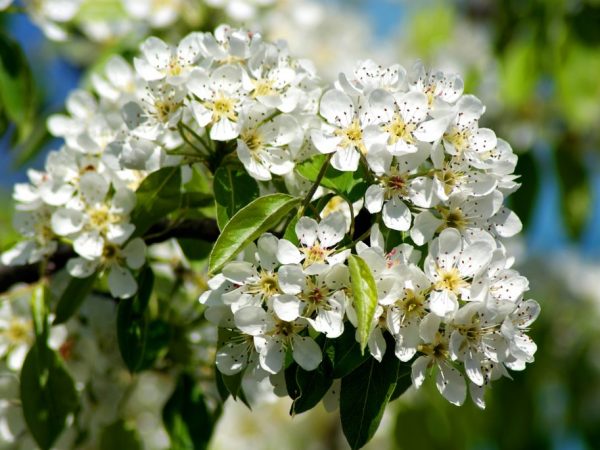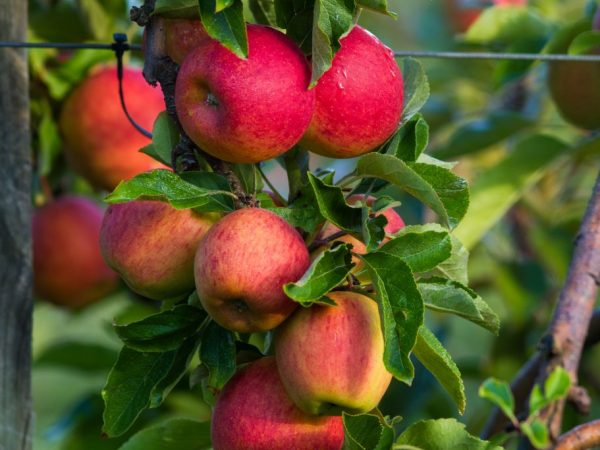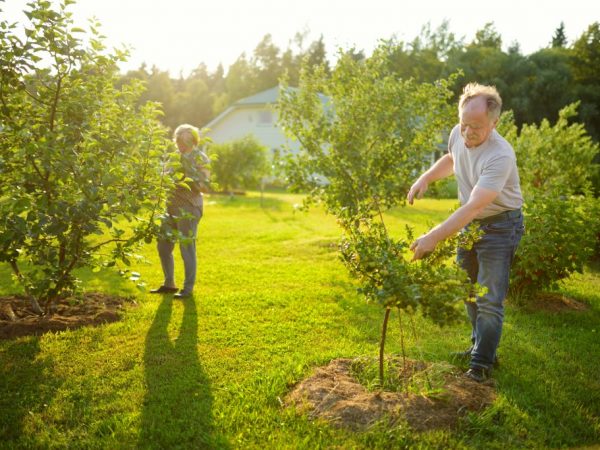Description of the Bellefleur-Chinese apple tree
One of the most popular late autumn varieties is the Bellefleur Chinese apple tree. It can be found in many gardens and summer cottages. The culture is often used as the basis for the development of new varieties. The fruits are small in size, sweet taste and delicate aroma.
- Variety characteristic
- Description of fruits
- Taste characteristic
- Yield
- Pollinating varieties
- Winter hardiness
- Disease and pest resistance
- In which regions are they grown
- Using
- Advantages and disadvantages of the variety
- Landing
- Landing dates
- Landing technology
- Care
- Watering
- Top dressing
- Pruning and shaping the crown
- Features of ripening and fruiting
- Harvesting and storage
- Gardeners reviews

Description of the Bellefleur-Chinese apple tree
Variety characteristic
For the first time, the Bellefleur hybrid appeared on the territory of Russia in 1908. The variety was distinguished by its resistance to harsh weather conditions. In those days, the apple tree was grown in the gardens of the middle zone of the country. Today this variety is grown mainly in the North Caucasus region and the Volga region.
The main characteristics of the species include:
- large and tall tree;
- the crown is branched, dense, voluminous;
- leaves are dark green, ribbed, with subtle veins;
- when blooming, large flowers are formed, 3-4 cm each.
Due to the short stalks, the fruits do not fall off the branches under the gusts of wind, during heavy rain.
Apple trees Bellefleur have lost their former popularity, because better varieties have appeared, but still the tree deserves a positive assessment, at least due to the excellent taste of the apples themselves.
Description of fruits
Fruits weighing 100-110 g. During ripening, their surface becomes saturated yellow. Above, there are strip-like outflows of a red hue.
Bellefleur apples are round, but depending on the pollinator, they can take on a slightly elongated, oval shape. The pulp is fine-grained, sweet, white.
Do not consume it immediately after harvest. To improve the taste characteristics, let the fruits lie for 10-14 days in a dry, dark place.
Taste characteristic
The Bellefleur Chinese apple variety stands out noticeably. The fruits are very sweet in taste, with a delicate pleasant honey aroma. They belong to the category of dessert fruits.
The pulp is white, with a yellow tint, juicy and crunchy. Fine grain is present. The tasters evaluate the taste characteristics of apples by 5 points.
Yield
The Bellefleur apple variety yields up to 160 kg per adult tree upon reaching the age of 12-18 years. The fruits do not fall off until fully ripe.
Pollinating varieties
The tree is not capable of bearing fruit on its own - it requires external pollination, so varieties need to be planted nearby:
- Antonovka;
- Brown Striped Miracle;
- Autumn Striped.
If there is no free space for planting, then you can graft a branch onto an already growing tree. Without pollination, it will produce much less fruit.
Winter hardiness
The apple tree belongs to those varieties that do not tolerate frost. For these reasons, it is not planted in all regions of our country.
To increase frost resistance, it is necessary to use seedlings that are well adapted to harsh climatic conditions (“Dream”, “Quinti” apple-trees) as a rootstock.
Disease and pest resistance
According to the description, the Chinese Bashkir hybrid Kitayka-Bellefleur is a plant with low resistance to fungal diseases.
Powdery mildew and scab (the most common ailments) affect mainly fruits (less often leaves).
To prevent infection, thinning of the tree crown is carried out every spring. Saplings are planted at a sufficient distance from each other. To increase the resistance of the apple tree to the effects of pathogenic organisms, it is recommended to spray the garden with a solution of Bordeaux liquid in early spring.
In which regions are they grown
The culture does not tolerate frosts, it is grown in the North Caucasian region, also in the Central or in the Voronezh region. Another hybrid is common in Armenia, Belarus and Ukraine.
Using
The fruit is used to prepare many delicious dishes. They are eaten raw, and they are also made with jam, juice, compote and fruit salads.
Advantages and disadvantages of the variety

Late apple tree with beautiful fruits
The advantages of the Bashkir variety will be its sweet taste and the appearance of the fruit. Also, the advantages include:
- the crop is stored for a long time;
- the tree bears fruit every year;
- good transportability of fruits;
- apples are large, have a beautiful presentation.
Despite this, he has no less significant disadvantages:
- the apple tree does not tolerate frost;
- fruits ripen late;
- the trees are tall, which makes harvesting difficult.
Young seedlings begin to bear fruit at the age of 5-7 years. And a bountiful harvest is harvested only at the onset of 20 years of age.
Landing
Two-year-old seedlings are planted in a permanent place. The tree does not tolerate a sharp gust of wind, the site must be protected and well lit by the sun.
Landing dates
Basically, the planting process takes place in the fall - in September or October (the seedlings will take root and take root better).
Spring planting is done from early April to May. At this time, the variety is planted only in the southern regions with a mild climate, it is desirable that the trees reach 3 years old.
Landing technology
Before planting, you need to dig a hole. Its size depends on the seedling itself. The larger the tree, the deeper and wider the hole will be.
On average, the dimensions of the hole should be as follows: diameter 80 cm, depth 60-80 cm.
If several trees are planned to be planted, the distance between them should be more than 5 meters. To accelerate growth, mineral or natural fertilizers are placed on the bottom of the pit:
- humus;
- compost;
- a mixture of bird droppings and wood ash.
Disembarkation is recommended 2 weeks after the preparation of the pit. When planting, it is necessary to correctly and carefully straighten the root system of the seedling for further growth. After that, it is necessary to pour with an ash solution - 2 kg of wood ash per 10 liters of water.
Care

Shaping the tree correctly
If you do not cut the apple tree (do not shape or peel the crown), the fruits will become smaller and lose their taste. This variety has an average drought tolerance, it does not require a lot of water.
Watering
On average, a Bellefleur Chinese apple tree needs three waterings.
- In spring - during the period of abundant sap flow - the second decade of March.
- In summer - during the period of especially hot days - the end of July and the beginning of August.
- In autumn - immediately after harvest.
During dry periods, watering should be done more often: every month. If the summer is rainy, watering can be reduced up to 2 times - spring and autumn.
Top dressing
Feeding is carried out in different ways, it depends on the season. Trees are fertilized 2 times a year.
In the spring, feeding is carried out with mixtures that include urea and ash. They are fed during the period when flowers appear: late April (25-20th day) - early May (1st-5th day).
And in the fall they fertilize after harvesting and before wintering.Superphosphate and a fertilizer mixture are used, which promotes further development and growth. It also protects against diseases and harmful insects.
Pruning and shaping the crown
In the spring, when the weather gets warmer, you can start pruning and shaping the crown of the tree.
This process will begin 2 years after the seedling is planted. During 1 pruning, you need to remove branches that create competition with the base.
Also, cut off any old or dry branches, and those that will make it difficult for the gardener to harvest. Cut off places must be covered with paint, which includes drying oil. This is necessary for better healing of the tree after this procedure.
Features of ripening and fruiting
The first full-fledged fruits begin to appear in the 4-5 year of the tree's life. But every year, with proper care, there are more and more apples and the fruits become larger.
Ripe fruits can be harvested already in September (biological ripeness), when the fruits are saturated with juice and turn red.
Harvesting and storage
The culture bears fruit abundantly every year.
If most apples are expected to be stored, it is important to harvest the unripe fruit so that it does not spoil during storage and transportation. The period of biological ripeness for this variety begins in early September - this is the best time for harvesting.
Gardeners reviews
In the characteristics of the Bellefleur Chinese apple tree, significant shortcomings are noticed. But, despite this, the reviews of gardeners about this variety are positive.
Most people appreciate the tree for its excellent taste.
Do not forget that the impressive height of the plant makes it difficult to harvest, so you need to make the obligatory spring pruning of the crown into the care system.

